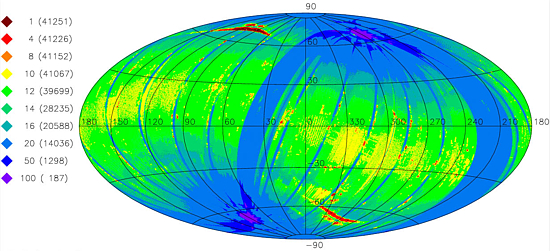NASA's Wide-field Infrared Survey Explorer (WISE; Wright et al. 2010) mapped the sky at 3.4, 4.6, 12, and 22 μm in 2010 with an angular resolution of 6.1" 6.4" 6.5" & 12.0" in the four bands. WISE achieved 5σ point source sensitivities better than 0.08, 0.11, 1 and 6 mJy in unconfused regions on the ecliptic in the four bands. Sensitivity improves toward the ecliptic poles due to denser coverage and lower zodiacal background.
For the non-astronomers reading this: WISE is a satellite that has mapped the sky at infrared wavelengths. Light from these wavelengths is invisible to the naked eye, but we perceive it as heat. All objects glow with light and the wavelength of peak emission depends on its temperature. For humans, with a typical temperature of 37 Celsius (98.6 Fahrenheit), the peak wavelength happens to be about 10 microns (μm). You can see that WISE probes wavelengths similar to this, so in principle it can observe objects as warm/cool as humans, though in practice these must be much physically larger in order to be detected.
There's actually a type of very cool objects out there known as brown dwarfs. Physically, these are objects that are not massive enough to have hydrogen fusion in their cores, which is the defining characteristic of a star. These brown dwarfs can range in mass from about 13 to 80 times the mass of Jupiter and are not much larger than Jupiter in size. The temperature for the coolest brown dwarfs discovered to date reaches 300 Kelvin (K). The Kelvin temperature scale is like Celsius, except shifted by 273 degrees, so this corresponds to 27 Celsius or 80 Fahrenheit.
Here are the relevant WISE temperature limits for brown dwarfs:
With WISE we will be able to see 450-K brown dwarfs out to a distance of 75 light-years (ly), 300-K brown dwarfs out to 20 ly, and 150-K brown dwarfs out to 10 ly.That's really cool (pun intended)!
With this data release, the full WISE catalog is available to everyone. Here's a map of the WISE coverage in Equatorial coordinates (right ascension and declination, different from the figure above):
The colors indicate how often an area has been observed. The more a particular area is observed, the fainter the objects that can be detected. As you can see from the figure, most of it is green indicating WISE observed most of the sky at least 12 times. UCLA's own Ned Wright is the principle investigator (the lead scientist responsible for the project) of the WISE mission so I'm sure everyone back there must be super excited.
In addition to the brown dwarfs already mentioned, WISE has also discovered plenty of asteroids and has studied distant dusty galaxies. These wavelengths are also useful when studying warm disks around nearby stars.
Here's a video with Amy Mainzer from JPL summarizing what WISE can do:
What else WISE can find will be up to the many astronomers that will soon be diving into the WISE data release. Given that useful science is still being carried out with the Two Micron All Sky Survey (2MASS) long after its completion (2001), we can anticipate that WISE data will play a key role in the astronomical research for the next few decades.
UPDATE: Here's a link to a very nice WISE mosaic of the sky. Similar to the first figure I have, but cleaner and it identifies some of the more famous regions in the sky.
And here's a nice Flash applet that allows you to zoom in through the WISE data.


No comments:
Post a Comment
Note: Only a member of this blog may post a comment.